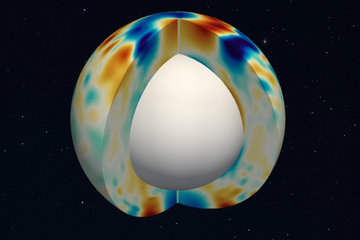All genres
21.
Journal Article
A solar coronal loop in a box: Energy generation and heating (Corrigendum). Astronomy and Astrophysics 669 (2023)
22.
Journal Article
Spectral variability of photospheric radiation due to faculae - II. Facular contrasts for cool main-sequence stars. Monthly Notices of the Royal Astronomical Society 524, pp. 1139 - 1155 (2023)
23.
Journal Article
Editorial to the Topical Collection: Solar and Stellar Dynamos: a New Era. Space Science Reviews 220, p. 2 (2023)
24.
Journal Article
No evidence for synchronization of the solar cycle by a "clock". Astronomy and Astrophysics 671, p. A87 (2023)
25.
Journal Article
Small-scale dynamo in cool stars. II. The effect of metallicity. Astronomy and Astrophysics 669, p. A157 (2023)
26.
Journal Article
Impact of spatially correlated fluctuations in sunspots on metrics related to magnetic twist. Astronomy and Astrophysics 664, p. A183 (2022)
27.
Journal Article
Theory of solar oscillations in the inertial frequency range: Amplitudes of equatorial modes from a nonlinear rotating convection simulation. Astronomy and Astrophysics 666, p. A135 (2022)
28.
Journal Article
Theory of solar oscillations in the inertial frequency range: Linear modes of the convection zone. Astronomy and Astrophysics 662, p. A16 (2022)
29.
Journal Article
Small-scale dynamo in cool stars. I. Changes in stratification and near-surface convection for main-sequence spectral types. Astronomy and Astrophysics 663, p. A166 (2022)
30.
Journal Article
Toroidal Flux Loss due to Flux Emergence Explains why Solar Cycles Rise Differently but Decay in a Similar Way. Physical Review Letters 129, p. 241102 (2022)
31.
Journal Article
Testing solar surface flux transport models in the first days after active region emergence. Astronomy and Astrophysics 660, A6 (2022)
32.
Journal Article
Testing solar surface flux transport models in the first days after active region emergence. Astronomy and Astrophysics 660, p. A6 (2022)
33.
Journal Article
The crucial role of surface magnetic fields for stellar dynamos: ϵ Eridani, 61 Cygni A, and the Sun. Astronomy and Astrophysics 661, p. A152 (2022)
34.
Journal Article
Faculae Cancel out on the Surfaces of Active Suns. The Astrophysical Journal 934, p. L23 (2022)
35.
Journal Article
Erratum: "Faculae Cancel out on the Surfaces of Active Suns" (2022, ApJL, 934, L23). The Astrophysical Journal 936, p. L17 (2022)
36.
Journal Article
Faculae Cancel out on the Surfaces of Active Suns. The Astrophysical Journal 934, p. L23 (2022)
37.
Journal Article
Chromospheric extension of the MURaM code. Astronomy and Astrophysics 664, p. A91 (2022)
38.
Journal Article
Can 1D Radiative-equilibrium Models of Faculae Be Used for Calculating Contamination of Transmission Spectra? The Astrophysical Journal 941, p. L35 (2022)
39.
Journal Article
Nonequilibrium Equation of State in Stellar Atmospheres. The Astrophysical Journal 911 (1), 71 (2021)
40.
Journal Article
Solar inertial modes: Observations, identification, and diagnostic promise. Astronomy and Astrophysics 652, L6 (2021)











